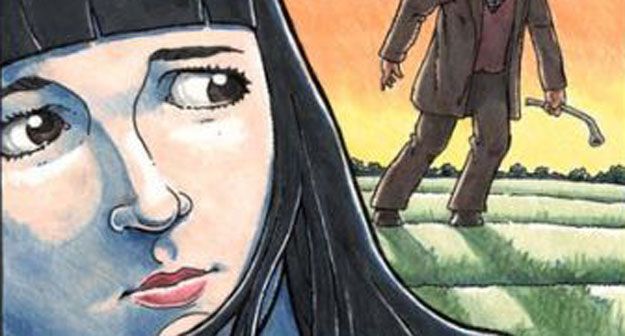Cartoonist Rick Geary owns the genre of true crime comics, having produced some 15 volumes of his Treasury series since 1987, chronicling the most famous and sensational murders of the Victorian era, and continuing toward the present.
His latest original graphic novel is a departure, a work of fiction telling a story that has, at its heart, a rather complex pair of murders. But it's not much of a departure. Not only is Geary's visual and verbal style unchanged, his interest in history, reality and ready-made characters is in tact. In Louise Brooks: Detective, Geary writes about a fictitious crime, but he uses a real protagonist, and sets the invented events within her biography.
That real protagonist is, of course, Louise Brooks, an actress from the dawn of the American motion picture industry, who is today probably best remembered for popularizing bangs and the bobbed haircut (in fact, that's in the first sentence of her Wikipedia entry), and for the grip she holds on the imagination of comics artists like John H. Striebel, Guido Crepax and Hugo Pratt, all of whom based characters on her.
And Geary, of course, who here uses her as a character.
Brooks' basic biography appears in a prose introduction by Geary, detailing her brief entertainment career, which started with her dancing as a chorus girl and led to Hollywood during the silent era. Just as sound pictures were beginning to be made, she decided to move to Europe to work with German expressionist director G.W. Pabst on Pandora's Box. Three films later, she moved back to the United States and struggled with dancing and acting for a while before briefly retreating to her family's home in Wichita, Kansas.
That's were Geary picks up her life and inserts his story. Has has Brooks narrate the book, and the fact that she wrote a memoir and spoke about this time in her life likely helped him to find a voice for her that closely complemented her real one.
While in Kansas as a 30-something, after having spent time as the toast of two continents, she struggles to fit in, and begins a friendship with a counter girl and music aficionado named Helen. The pair bond over a locked-door murder mystery that's been dominating the newspaper headlines, involving a wealthy widow with three suspicious suitors.
Brooks, Helen and everyone else in town play armchair detective, but our heroine and her friend soon find themselves embroiled -- through a series of coincidences -- in another murder, this one more brutal still: Rather than wealthy widow being stabbed in her sleep, this one involves a motorist having his head caved in by a hobo with a tire iron.
For all the events that occur, Geary's story is a fleet one: just 80 pages. As slim a volume as it is, and as fast as it moves, it's remarkably full, with few if any pages or panels wasted, much of them devoted to either telling bits of Brooks' biography or parts of the murder case, even if many of them don't seem relevant at the time. In an impressive feat, Geary is able to tie up everything by the final page, drawing together seemingly disconnected elements in ways that are surprising but immensely satisfying. This is a work of incredible efficiency, and one that would be difficult to apply the coincidences that really aren't, symmetries and parallels to a bit of true crime. Reality, as amazing as it, isn't as clean and perfect as well-constructed fiction.
Geary brings the same sense of rigor in research to this project as his others, with delicately drawn period details, and even supplementary material like maps. While casting real celebrities of the arts as mystery novel heroes is old hat in prose – Jane Austen, Louisa May Alcott, Beatrix Potter, Jack London, Groucho Marx, Greta Garbo, etc. – it's infinitely less so in comics, and because this particular mystery involves a murderer who pretends to be other characters throughout, Geary is free to provide subtle visual clues that don't draw attention to themselves in the way that a prose story might, where descriptions of the characters' would be needed, or a film story might, where the same actor would be called on to play any characters disguised as other characters.
With the murders both solved by the end of the book, Brooks decides to move to New York City and begin the next phase of her life.
"While waiting on the platform, I recalled that day so many years ago when a vain and insolent little dancer, age 15, set out on her first journey to New York," Brooks says in narration. "So much had happened since then ... Where was she now? Who was she?"
"I suppose I was still finding out," she concludes. Hopefully, she was going to continue to be an amateur detective in future comics by Rick Geary.

